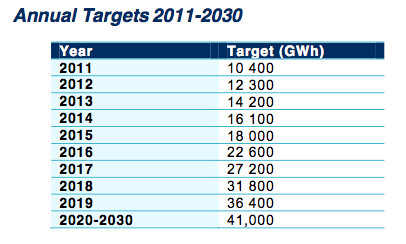Small-scale Renewable Energy Scheme and Large-scale Renewable Energy Target: Once RECs, now STCs, and LGCs
The first is that it has been split into two categories: the Large-Scale Renewable Energy Target (LRET) and the Small-Scale Renewable Energy Scheme (SRES). The LRET has been determined in terms of GWh (Gigawatt hours) per year (see Table 1), whereas the SRES’s Small-scale Percentage Target (STP) is set in terms of a percentage of the liable party’s obligations as set out under the eRET legislation (see the example below, from the ORER STP web page). The STP will change annually. This year it is 14.8%, but it has not yet been determined for future years.
For example, in 2011 the STP is 14.80%. A liable entity’s assessment year’s reduced acquisition equals 110,000 MWh of electricity purchased in 2011 (relevant acquisitions) less 10,000 MWh partial exemption certificates received from customers conducting emission intensive trade exposed activities in 2011 “ 12. The liable entity in 2012 must have surrendered 14,800 STCs to fully discharge their liability under SRES in 2011 “ 2012 for this year or pay the small-scale technology shortfall charge $962,000 (14,800*$65) or less.

As with the old RET, ‘liable parties’ such as electricity companies and energy-intensive industries are still required to purchase a number of RECs. However, under the eRET, there are now two types of RECs, and a quota for each. A certain number of these certificates must be Large-scale Generation Certificates (LGCs*, to be surrendered by liable parties annually), and a certain number must be Small-scale Generation Certificates (STCs**, to be surrendered quarterly).
The main idea behind these changes is to promote not only smaller-scale residential renewable energy generation, which has seen a steady increase over the past few years, but also to encourage greater development in the realm of grander projects, which have seen relatively less action and investment. If you are thinking about installing a system on your home, you will now be granted STCs. (N.B. If you have any RECs from the years 2001 to 2010 unsold and still in the registry, these will be converted into and sold on the REC market as LGCs.)
STC Clearing House: a stable market for your certificates
The second major change is that, as of 5 January 2011, the STC Clearing House is open for business. A little bit of background: you may be aware that under the old scheme, one REC was created for every 1MWh of electricity produced, and that liable parties were obligated to purchase and submit a certain number of RECs periodically. The same basic idea is still true now, but each liable party has both an STC and a LGC obligation in place of the less specific REC target. Certificates are produced when renewable generation capacity is installed. When you the homeowner install a solar system on your property, depending on its size, you will be eligible either 1) to apply for your STCs yourself on the REC Registry or 2) to submit your right to apply for them to an agent, usually your installer, who will pay you for them upfront and you don’t have to think about concern yourself with price fluctuations or think about the ideal time to sell them. For those who have chosen to register for the certificates themselves, the STC Clearing House provides a marketplace for certificates that guarantees a set price of $40 (not including GST) per STC, but does not necessarily guarantee a buyer right away. As STCs are a tradeable commodity, you are also of course have the option of taking your chances with the ordinary REC market, where prices constantly fluctuate. Which path you choose is up to you.
For more details about these new schemes, you can check out the Office of the Renewable Energy Regulator (ORER) website for updates on the new processes that are now in place.
* “1 MWh of eligible renewable electricity generated above the power station baseline.” Please see ORER’s FAQ.
** “1 MWh of renewable electricity deemed to be generated by small generation units unless the Solar Credits multiplier applies; or 1 MWh of electricity deemed to be displaced by the installation of solar water heaters.” Please see ORER’s FAQ.
Written by James Martin
Solar Choice Analyst
© 2010 Solar Choice Pty Ltd
Sources and Links:
Office of the Renewable Energy Regulator, “What’s new”
Office of the Renewable Energy Regulator, STC Clearing House page
An excellent, detailed, and informative FAQ about the STC Clearing House and the SRES and LRET is available here (pdf). (Images in this entry are taken from this FAQ.)
Previous Solar Choice blogs: RECs and how they are calculated : Amendments to the enhanced Renewable Energy Target : Improvements to the REC scheme
- Solar Power Wagga Wagga, NSW – Compare outputs, returns and installers - 13 March, 2025
- Monocrystalline vs Polycrystalline Solar Panels: Busting Myths - 11 November, 2024
- Solar Hot Water System: Everything You Need to Know - 27 February, 2024